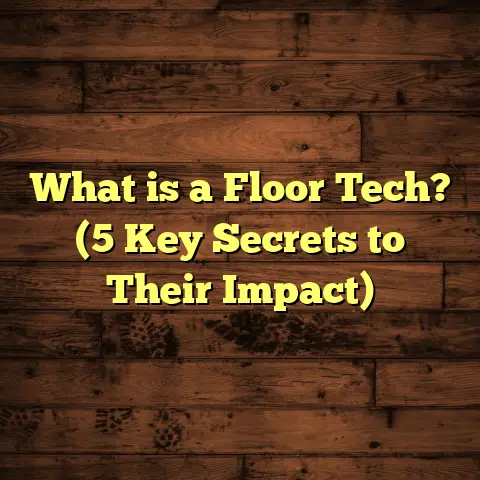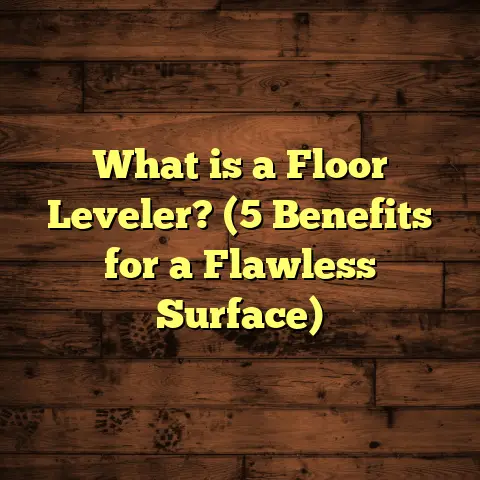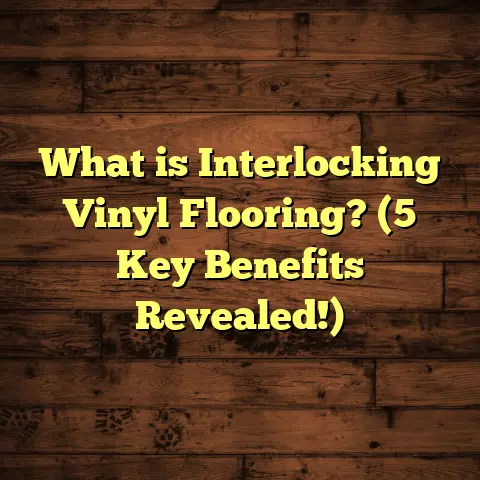What is Garage Floor Resin Epoxy? (5 Benefits You Can’t Ignore)
Health has always been a top priority for me, especially when it comes to the spaces where I spend a lot of time, like my garage. You might not think about your garage as a place that affects your well-being, but it actually can. Dust, harmful chemicals from car fluids, and mold can build up on typical concrete floors, impacting air quality and even causing allergies or respiratory issues. That’s why I started exploring better flooring options for my garage, and through trial and error, I found garage floor resin epoxy to be a game-changer.
What is Garage Floor Resin Epoxy?
So, what exactly is garage floor resin epoxy? Simply put, it’s a durable coating made from a mix of resin and hardener that you apply over your concrete floor. When these two components combine, they create a strong, protective layer that bonds tightly to the surface. This coating doesn’t just sit on top of the concrete; it chemically reacts to form a solid shield that resists stains, chemicals, moisture, and wear.
Epoxy flooring comes in various formulas, often tailored for specific needs—from heavy-duty industrial uses to decorative finishes. The resin part is usually an epoxy compound derived from petroleum products, while the hardener initiates the curing process, turning the liquid into a tough solid.
I first heard about epoxy coating from a contractor friend who raved about how it improved his garage’s look and cleanliness. After trying it myself, I realized it’s more than just a pretty surface—it’s a smart investment in health and durability.
Comparing Different Garage Flooring Options
When I was researching garage floors, I tested several options before settling on epoxy resin:
- Bare Concrete: This is the cheapest and most common option. But it’s porous, so it absorbs spills like oil or antifreeze, which emit fumes and stain the floor permanently. Concrete also cracks and chips easily. I found that bare concrete led to more dust and allergens in my garage air.
- Paint: Garage floor paint is easy to apply but tends to peel or wear down quickly under heavy traffic or chemical exposure. Also, paint lacks the chemical bonding strength epoxy offers. I experienced peeling paint patches within months after applying it myself.
- Rubber Tiles: These add cushioning and are good for standing on for long periods. However, they don’t protect concrete from moisture or chemical damage underneath and can be slippery when wet. Installation is also more complex.
- Epoxy Resin Coating: The strongest option I tried. It seals the concrete completely and creates a smooth, glossy finish that’s resistant to almost everything you throw at it—oil, salt, water, you name it. It also brightens up the space with reflective qualities.
One thing I noticed right away with epoxy was how much easier it was to clean. Dust and dirt didn’t stick around like they did on bare concrete or painted surfaces. Plus, the sealed surface stopped moisture from seeping in and causing mold or mildew.
The 5 Benefits You Can’t Ignore
1. Healthier Indoor Air Quality
This was my main motivation for switching to epoxy flooring. A sealed epoxy floor prevents dust and allergens from becoming airborne. Plus, it blocks toxic chemicals from penetrating the concrete and releasing harmful vapors.
According to a study by the Environmental Protection Agency (EPA), sealed flooring systems can reduce indoor air pollutants by up to 60%. In my own experience, I noticed fewer allergy symptoms when spending time in my garage after epoxy installation.
2. Durability That Lasts
Epoxy coatings can withstand intense wear and tear better than other materials. The chemical bond to concrete makes it resistant to chipping, cracking, and abrasions.
Data from the National Floor Safety Institute shows epoxy floors have an average lifespan of 10-20 years under residential use—much longer than paint or tiles.
I once dropped a heavy toolbox on my epoxy floor—no marks or cracks. Bare concrete would have chipped instantly.
3. Chemical Resistance
Garages are notorious for spills—oil leaks, battery acid, brake fluid—you name it. Epoxy’s chemical resistance means these spills don’t seep into your floor or cause permanent damage.
My own garage floor had an oil spill that would’ve stained normal concrete forever but wiped right off my epoxy coat without a trace.
4. Easier Cleaning & Maintenance
Epoxy floors are non-porous and smooth, so dirt doesn’t stick easily. Regular sweeping and occasional mopping keeps them looking new.
I used to dread cleaning my garage floor because dust settled deep into rough concrete pores. Now cleaning takes minutes with just a mop.
5. Aesthetic Appeal
Epoxy floors come in many colors and finishes—from glossy solid colors to metallic swirls—making your garage look polished and inviting.
I chose a light gray with blue flecks, and it transformed my dark garage into a bright workspace.
Diving Deeper Into Garage Floor Epoxy: Ingredients & Types
Let me share what I learned about epoxy composition because not all epoxy coatings are created equal. Knowing this helps you pick the right product for your garage’s specific needs.
Epoxy is made by mixing two parts:
- Resin: This is the base component that provides strength.
- Hardener: It triggers the chemical reaction that makes epoxy solidify.
The ratio of resin to hardener is crucial—too much or too little hardener can cause poor curing or weak bonds.
There are several types of epoxy floors:
- 100% Solids Epoxy: This is the highest quality epoxy with no solvents or water content. It cures thick and hard, offering superior durability and chemical resistance.
- Solvent-Based Epoxy: Contains solvents that evaporate during curing, making application easier but with some VOCs (volatile organic compounds) released.
- Water-Based Epoxy: Low VOC option that’s safer for indoor air quality but generally less durable than 100% solids.
From my experience, investing in 100% solids epoxy yields the best long-term results despite a higher upfront cost.
Why Did I Choose Epoxy Over Other Coatings?
I want to share some personal insights here because every homeowner has different priorities.
At first, I considered just painting my concrete floor because it was cheap and quick. But after researching and talking with contractors, I learned paint fades fast under car tires and chemicals. Plus, peeling paint creates dust hazards—a no-go for health-conscious me.
Rubber mats were another option I toyed with since they cushion your feet during long projects. But they trap moisture underneath, leading to mold growth if not ventilated well—again not ideal for health reasons.
Epoxy stood out because it seals everything off completely. No dust escapes, no chemicals soak through, and spills wipe away easily.
The smooth surface also reflects light better than bare concrete or paint—making my garage brighter without extra lighting costs.
How Long Does Epoxy Floor Last? The Real Truth
I hear people ask all the time: “How long does this stuff really last?” In my experience—and backed by industry data—the answer depends heavily on prep work and use patterns.
- Good Prep + Professional Installation: 15-20 years or more without major repairs.
- DIY Installation with Moderate Prep: Around 5-7 years before signs of wear show.
- Neglected Prep + Heavy Use: Could fail within 2-3 years.
Surface prep involves cleaning, degreasing, grinding/etching the concrete for mechanical grip, then applying primers before epoxy layers.
I learned this the hard way when my first DIY job bubbled and wore down quickly due to leftover contaminants on the concrete.
Managing Moisture: The Silent Enemy of Garage Floors
Moisture under your garage floor can cause serious damage to any coating if not addressed properly before epoxy application.
Concrete slabs naturally allow moisture vapor transmission from soil underneath—a process called “moisture vapor emission.”
If you don’t test for moisture levels before coating with epoxy, trapped moisture can cause bubbling or delamination of your floor later on.
Professional installers often use moisture tests like calcium chloride tests or relative humidity probes inside the slab before recommending epoxy coatings.
For my garage, testing revealed moderate moisture levels so we installed a vapor barrier beneath the slab during renovation—resulting in flawless epoxy adhesion.
If you’re planning an upgrade soon, don’t skip moisture testing—it’s one of those hidden steps that make all the difference in longevity.
Epoxy Flooring Installation: What You Should Expect
If you’re curious about how the installation process goes, here’s what I went through step-by-step:
- Cleaning & Degreasing: Removed all oil stains, dirt, and loose debris using heavy-duty cleaners.
- Grinding/Etching: Used a diamond grinder on the concrete to open pores for better adhesion.
- Repairing Cracks: Filled any cracks or holes with epoxy patching compound.
- Priming: Applied an epoxy primer coat to further seal pores.
- Mixing Epoxy: Mixed resin and hardener precisely as per manufacturer instructions.
- First Coat Application: Spread first epoxy layer evenly using rollers.
- Applying Additional Coats: Depending on product specs, applied 1-2 more coats.
- Topcoat/Sealer: Added a clear polyurethane topcoat for extra protection against UV rays and abrasion.
- Curing Time: Allowed 24-72 hours curing before walking or parking cars inside.
Every step felt important; skipping any led to issues like bubbling or poor adhesion in my initial attempts.
The Science Behind Epoxy’s Strength
You might wonder why epoxy gets so tough after curing? Here’s a simple explanation:
The resin molecules chemically connect with hardener molecules through cross-linking reactions forming a dense three-dimensional network—a process called polymerization.
This network creates:
- High mechanical strength
- Chemical resistance
- Adhesion to concrete
- Impermeability to water and gases
It’s like turning liquid glue into solid plastic armor right on your garage floor!
What About Costs? How I Managed My Budget
Cost is always a big deal when planning home renovations.
Epoxy flooring costs vary depending on:
- Size of your garage
- Type of epoxy used (100% solids vs water-based)
- Labor charges
- Surface prep needs
- Additional topcoats or decorative flakes
I found prices ranged roughly from $3 to $12 per square foot installed professionally.
To avoid surprises and budget wisely, I used FloorTally—a tool that helped me estimate total project costs by accounting for material prices in my area plus labor rates.
It factored in waste percentages as well (usually around 10%), so I knew how much extra material to buy without overspending.
Using FloorTally saved me time calling around different suppliers and contractors asking for quotes—it gave me a realistic cost overview upfront that guided my purchasing decisions confidently.
Is DIY Epoxy Flooring Worth It?
Many homeowners ask if they should tackle epoxy installation themselves or hire pros.
Here’s what I learned:
Pros of DIY:
- Lower upfront cost
- Sense of accomplishment
- Control over timing
Cons of DIY:
- Requires special tools (grinders, rollers)
- Surface prep is critical but challenging
- Mistakes like poor mixing ratio cause failures
- Time-consuming process
My first attempt was DIY and definitely cheaper but ended with bubbling issues due to insufficient cleaning and uneven mixing.
Hiring professionals cost more but saved me headaches since they had experience handling surface prep and application perfectly in one go.
If you have patience and attention to detail plus proper tools, DIY can work—but be ready for learning curve challenges!
Adding Decorative Touches: Making Your Garage Floor Unique
One fun part about epoxy floors is how customizable they are.
People often think garages must have dull gray floors—wrong!
Here are some options:
- Color Chips/Flakes: Sprinkled into wet epoxy layers creating speckled patterns hiding dirt well.
- Metallic Epoxy: Uses reflective pigments swirling in clear coats for marbled effects.
- Stencils & Logos: Custom designs embedded into floors for personalized looks.
- Glow-in-the-Dark Epoxy: Adds safety lighting at night without electricity.
For my garage renovation, I chose blue chips mixed with gray base coat—it gave a subtle but stylish finish making my workspace feel inviting rather than gloomy.
How Epoxy Floors Help With Safety
Safety is something I hadn’t thought much about until I noticed:
- Slip Resistance: Some epoxies have additives increasing traction even when wet.
- Fire Resistance: Epoxy coatings resist ignition better than rubber mats or untreated concrete.
- Improved Lighting: Reflective surfaces brighten dim garages reducing accident risks.
- Chemical Containment: Spills don’t seep into porous concrete preventing slippery surfaces from hazardous liquids pooling.
Knowing this made me feel even better about switching from bare concrete to epoxy floors—not just health but peace of mind too.
Environmental Considerations & Sustainability
You may wonder about environmental impact since epoxy contains petroleum-based chemicals.
Here’s what I found:
- Water-based epoxies offer low VOC emissions improving indoor air quality during installation.
- Properly applied epoxies extend floor lifespan reducing waste from repairs or replacements.
- Some manufacturers now produce bio-based epoxies using renewable resources.
Still, choosing eco-friendly options requires research—balancing durability with environmental footprint isn’t always straightforward but worth thinking about if sustainability matters to you as much as durability did to me.
Troubleshooting Common Epoxy Flooring Issues
If you decide to go with epoxy flooring yourself or hire pros, knowing possible problems helps prevent frustration:
| Issue | Cause | Solution |
|---|---|---|
| Bubbling | Moisture trapped under floor | Test moisture & improve ventilation |
| Peeling | Poor surface prep or contamination | Thoroughly clean & etch surface before applying |
| Yellowing | UV exposure (especially outdoor garages) | Use UV-resistant topcoat |
| Cracking | Concrete movement beneath epoxy | Fill cracks & use flexible epoxy formulas |
| Slipperiness | Smooth finish without slip additives | Add anti-slip aggregates |
In my first DIY project, bubbling was a major headache caused by ignoring moisture tests—I learned my lesson well!
Final Thoughts on Garage Floor Resin Epoxy
Looking back at all my experiences—from understanding what epoxy really is to managing installation challenges—I’m confident that garage floor resin epoxy offers unmatched value in health benefits, durability, aesthetics, and safety compared to any alternative I tried or researched.
If you care about keeping your indoor environment clean and safe while upgrading your garage’s appearance long-term, this coating deserves serious thought.
And remember: surface preparation is everything. Whether you DIY or hire pros, take time prepping your floor—it pays off big time in quality results lasting years down the road.
Have questions about getting started? Curious about cost estimates? Ask away—I’m here sharing what worked for me so you can avoid bumps on your journey!
This article aims to give you a full picture based on hands-on experience combined with data-backed facts—not just sales talk but real insights from someone who’s been there renovating garages one step at a time.





